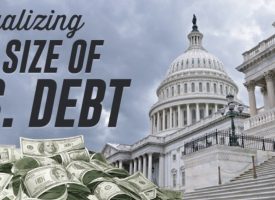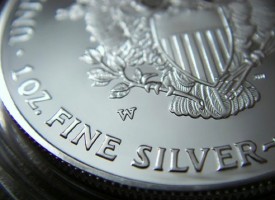Today one of the greats in the business released his top 10 things gold & silver investors should watch in 2022.
Top 10 For 2022
January 20 (King World News) – Paul Wong, Market Strategist at Sprott Asset Management: 2021 was a great year for risk assets. Broad equity benchmarks made all-time highs with one of the lowest realized volatility since 2017. This high return with low volatility was noteworthy given that inflation is running at 40-year highs, new COVID variants are impacting the world and valuations are already at very high historical levels. Part of this impressive return was due to the monetary and fiscal liquidity that is now fading. The global inflation surge was the biggest surprise for 2021, forcing G10 central banks to taper or end asset purchases (QE or quantitative easing) earlier than expected. This monetary policy “normalization process” is expected to broaden and deepen in 2022.
Despite a strong tailwind from the global recovery and the positive environment for risk assets, investment strategies were buffeted by short and volatile rotations in thematic and factor trades, steepening and flattening swings in the yield curve and volatility swings. Though the major stock market indices climbed higher, the very narrow breadth and gyrating rotations belied a less robust stock market than observed only from an index level. Highly speculative and hyper-growth equities have already experienced dramatic sell-offs. The incredible spread of the COVID Omicron variant looks to prolong the already problematic supply chain issues and increase wage pressures, adding to near-term inflation angst. With equities trading at lofty levels, margin compression in place, a wary consumer and Federal Reserve (“Fed”) tightening, high inflation is already biting into profit margins as real consumer spending shows signs of flattening.
Gold Bullion Lost 3.64%, But on Average Traded Higher in 2021
Spot gold closed the year at $1,829.20, down $69.16 or 3.64% from the December 31, 2020, close of $1,898.36. For 2021, the average gold price was $1,799.27 compared to the 2020 average price of $1,770.25, increasing $29.47 or 1.66%. Gold began 2021 under enormous downside pressure falling over $250/oz. by early March as funds exited gold in favor of the accelerating reflation trade. The first indication of a Fed taper/tightening was also signaled in Q1, bringing back painful memories of the impact of the 2013 Taper Tantrum on gold. During Q2, the first series of surprise inflation prints hit the market, and gold as a traditional inflation hedge recovered most of the initial price fall. By the June FOMC (Federal Open Market Committee Meeting), the market had shifted to expect a more hawkish Fed stance, and again, gold pulled back. During the second half of 2021, gold settled into a narrower trading range as gold traded between inflation and rate hike outlooks. Though signs of an economic slowdown became more evident, inflation surged even higher in Q4 along with a view the Fed would have to accelerate taper and rate hikes. When the Fed finally announced it would taper during the November FOMC and its accelerated taper in the December FOMC, gold bullion rallied both times, breaking the 2013 Taper Tantrum trading pattern. We have viewed the nearly one-and-a-half years of gold trading as a consolidation…
VERY BIG DEAL!
This exploration company just made one of the biggest
acquisitions of 2021 that stunned investors!
To learn more click here or on the image below

The market dynamics that have been in place and evolving since the GFC (global financial crisis), now 14 years ago (2008-2010), continue to drive gold prices. Since the GFC, there remains the unresolved problem of too much debt, which continues to expand. Not only are the original emergency measures (i.e., Fed balance sheet) are still in place, but every crisis event since has only extended and entrenched these emergency measures. The latest tools deployed by the Fed, including ZIRP (zero interest rate policy) and AIT (average inflation targeting) and 2020’s massive QE program to create inflation and depreciate debt, have overshot and created other problems. Since the GFC, the Fed has been trying to ignite “good inflation” (wage inflation), not the “bad kind of inflation” (asset and consumer inflation). The consumer price index (CPI) is now at 40-year highs (far over the Fed’s 2% AIT), the American wealth divide is possibly at its widest ever and wage inflation threatens to break higher.
Though inflation is running at 40-year highs, U.S. 10-year Treasury yields remain relatively subdued, resulting in deep negative real yields last seen in the 1970s. If the Fed has broken the correlation between inflation and interest rates, then real wealth will continue to erode as the Fed accelerates the debasement of debt. Furthermore, U.S. 10-year Treasury yields are a reference which almost all assets use for pricing. Artificially low yields in sovereign bonds may mean a significant disconnect between the risk-free rate and fundamentals. In other words, market risk is very underpriced and the developing rate shock threatens a mark-to-market on risk.
For our Top 10 List, we will review the long-term secular drivers of gold and the Fed rate cycle. With the Fed and most other G10 central banks beginning the rate hiking cycle, we will highlight some important considerations that may influence gold price dynamics in 2022.
The top 10 things we think gold/precious metals investors should watch in 2022:
#1. M2 Money Supply, U.S. 10-Year Treasury Real Yields and U.S. Dollar (USD)
#2. Across the Board Declining Monetary and Fiscal Impulses
#3. Higher Macro Risk Levels
#4. A Hawkish Fed
#5. Waiting for the Powell Pivot 2.0
#6. Portfolio Risk
#7. Reflation Flows Back to Haven Flows
#8. Non-Investment Gold Buyers Returning
#9. Positioning and Sentiment for Gold Bullion and Gold Equities
#10. Gold Equities at Extreme Low Valuation
We break up our Top 10 Watch List into three categories: A) The Long Term Secular Drivers of Gold Bullion; B) Fading Liquidity Cycle and Rising Risk; and C) Reversal of Flow of Funds.
Part A: The Long-Term Secular Drivers of Gold Bullion
#1. M2 Money Supply, U.S. 10-Year Treasury Real Yields and U.S. Dollar (USD)
All three of these variables are driven by monetary and fiscal policies. U.S. debt has expanded since the GFC threefold and M2 has tripled (both ~8% annualized rate since the GFC). The spending response to COVID has seen U.S. debt-to-GDP increase to 130%, the highest since World War II. To manage this extremely high level of debt, real yields, as measured by U.S. 10-year TIPs (Treasury Inflation-Protected Securities) yields, have fallen to their lowest levels ever (financial repression).
U.S. dollar price levels are more complicated and are affected by many more factors. One of the most significant factors for a lower USD level is that a high USD will tighten global financial conditions, which is undesirable to central banks. The main factor for USD strength is the global demand for USD liquidity and funding due to the very high level of foreign USD-denominated debt. Overall we see the long-term secular trend for the USD as lower but with counter-trend price moves.
Over the past 25 years, multiple regression analysis shows that M2, the TIPS yield and the DXY US Dollar Index explain about 90% of the movement in gold. Figure 1 presents our Primary Gold Model based on the three main variables, and it remains in an upward trend. Since June 2020 (post-emergency COVID spending), M2 has increased at an annualized 12.5% rate. With the Fed warning of higher and more persistent inflation in 2022 and 10-year U.S. nominal yields still in a range, we expect to see real yields (as measured by 10-year U.S. Treasury yield less CPI) around the lows of the 1970s.
Part B. Fading Liquidity Cycle and Rising Risk
#2. Across the Board Declining Monetary and Fiscal Impulses
In previous comments, we have noted that global M2 money supply and global credit impulses peaked over a year ago but that due to a lag effect, their impact would not be felt until Q1 of 2022. Along with slowing money supply growth and new credit expansion, there will be a marked reduction in expected fiscal stimulus (i.e., Build Back Better). Developed market central banks have started the taper process and rate hikes will begin in earnest shortly. Central bank balance sheet growth has already peaked, but by the second half of 2022, they will start to shrink (quantitative tightening).
The reduction in central bank balance sheet growth (QE programs) will directly and immediately impact risk asset prices. Since 2009 (post-GFC), global central banks (the Fed, the European Central Bank and the Bank of Japan) have increased their balance sheets at a 12.6% annualized rate. By early 2022, the global central banks’ balance sheet year-over-year change will be at 0%. Historically, when this 0% level is reached (see Figure 2 lower panel), financial risk events tend to surface as these issues can no longer be papered over (pun intended).
#3. Higher Macro Risk Levels
With virtually all significant sources of liquidity scheduled to fade simultaneously this year, susceptibility to macro risk is likely to rise. Overall, risks are growing, but they also remain ambiguous and hard to quantify, allowing for a broader range of outcomes. Unpredictable and unanchored inflation is likely to translate into higher macro risk. Throughout 2021, inflation surprise and inflation uncertainty indices were at all-time highs despite the consensus view that inflation was “transitory”. Unprecedented levels of stimulus led to demand-pull inflation, and the effects of the COVID pandemic disrupted supply chains to chaotic levels resulting in cost-push inflation. Other unpredictable risk factors remain another troublesome COVID variant, geopolitics, a global energy crunch and developments in China. Various levels of macro risk will always be present. Still, with fading liquidity, a hawkish Fed, a lower bar for the Fed put and high valuations with rising interest rates, the ability to buffer and absorb risk has been dramatically reduced.
#4. A Hawkish Fed
After messaging a patient, measured and gradual approach to tapering and tightening for most of 2021, the Fed has shifted hawkishly to a faster taper, more and earlier rate hikes, and now a faster balance sheet reduction (quantitative tightening or QT). The rapid transition to quicker and more frequent rate hikes and QT probably speaks clearly whether the Fed was behind the curve. The abrupt swing in monetary policy from outright easing to outright tightening has also increased the odds of rate-driven “accidents” in financial markets. Higher rate structures alone have the potential to move the risk-premium higher, but sudden sharp moves in yields are likely outpace the market’s ability to reprice and re-position.
It is hard to ignore that inflation is a political liability for the current Biden Administration. With only ~54% of the U.S. population reporting that they own equities, is inflation a more significant political risk than a severe market correction? Until inflation calms down or the political optics improve, the Fed put strike price is likely lower now than it was only a few months ago. If inflation were to accelerate while the Fed was tightening, there is a lower likely probability that the Fed would intervene with dovish action if a risk event were to occur.
#5. Waiting for the Powell Pivot 2.0
Historically, Fed tightening cycles tend to end with a “financial event.” The Fed’s hands are tied and will tighten now, reducing liquidity and slowing an economy already in a maturing late-cycle phase. The risk is that developed market central banks have waited too long to tighten and are now at the brink of a significant policy error. Policymakers have an asymmetric response in that the bar to ease is much lower than the bar to hike, and QE is the policy of first resort. The effect of QE over time is a persistent bid from a massive price-insensitive buyer for government bonds and corporate credit. The constant bid drives yields lower and pushes investors out on the risk curve and down the quality ladder. QE not only inhibits price discovery but also suppresses volatility. Not only is volatility artificially low due to QE, but yield enhancement strategies (shorting volatility to generate income) have proliferated in response to ZIRP, have driven volatility lower and have distorted the volatility curve.
We believe the removal of asset purchases (QE) and QT are likely to lead to price discovery on asset prices and risk. When the Fed, a massive price-insensitive buyer, not only steps away but starts to sell, it is not hard to imagine that the “risk channels” will become more active and efficient, and risk will be priced more acutely. The question becomes, how long before the market forces a dovish pivot again? Several months before the Powell Pivot in January 2019, gold dipped to its trading low in August 2018, partially in anticipation of the Fed being pushed back into a dovish posture. We see a similar situation unfolding in 2022.
#6. Portfolio Risk
With inflation so elevated and likely to persist longer than expected, the risk of continuing the decades-long negative stock-bond correlation remains highly questionable. A breakdown of this negative correlation is a primary source of risk for multi-asset portfolios. Only one week into 2022, and we appear to be in the early stages of a rate shock (or tantrum). The challenge to hedge a portfolio when the risk-free asset becomes the primary source of risk in a multi-asset portfolio will lead to more safe haven allocations.
Since 2016, gold bullion has continued to outperform the U.S. Treasury Index by 46.7% (or 6.6% annualized). From January 2016 to December 2021, gold bullion also had a better sharpe ratio of 0.62 versus 0.48 for the U.S. Treasury Index. In Figure 3, we highlight the gold to U.S. Treasury Index Ratio. Currently, the ratio is shaping into a bullish flag pattern (red lines) beneath the major resistance level (green dashed line). We expect this ratio to break out higher in 2022.
Part C. Reversal of Flow of Funds
#7. Reflation Flows Back to Haven Flows
During Q4 2020, the relation trade was ignited by the COVID vaccine breakthrough, which led to the re-opening of the economy, a Democratic election sweep ushering in staggering levels of fiscal stimulus and a wave of new credit expansion (credit impulse). We witnessed a significant rotation into industrial metals such as copper and away from gold, as funds were caught well underexposed to the reflation trade.
The gold-to-copper ratio is a popular macroeconomic growth expansion/contraction indicator. Figure 4 shows the gold-to-copper ratio overlain with global credit impulse (without lag adjustment). When there is too much economic weakness, credit impulse will turn up as policymakers begin the process of turning on the stimulus channels. Gold outperforms copper (reflation back to haven) when stimulus turns up as liquidity starts to revert. Since the GFC, a cyclical growth cycle has been expected to return with copper outperforming gold, but these expectations have not been met (yet). We will likely see another reversal of flows returning to gold from the reflation trade in 2022.
#8. Non-Investment Gold Buyers Returning
There are three substantial non-investment type demand drivers of gold: China and India gold imports (which combined represent ~50% world demand) and central bank purchases (~15% demand). For the past decade, these significant sources of demand have tended to provide a long-term support level for gold bullion. In broad terms, these buyers are price elastic or price opportunistic. During periods of strong investment demand, gold purchases from China, India and central banks typically slow, and vice versa. When COVID first hit in 2020, consumer gold demand fell sharply from economies shuttering to contain the spread of the virus. Strong investment demand drove gold prices higher during 2020 and decelerated China and India’s gold imports. With economies re-opening in 2021 and gold prices down from all-time highs, gold imports to India and China and central bank gold purchases have begun reaccelerating. In the past 12 months, total gold imports/purchases have increased to an annual rate of 2,200 tonnes (Figure 5). Expectations are for consumer demand in India and China to recover further while central bank purchases continue to increase from countries wishing to diversify away from USD hegemony.
#9. Positioning and Sentiment for Gold Bullion and Gold Equities
In the most basic terms, gold positioning and sentiment are at washout levels. The old traders’ adage that price lows are made when sellers are exhausted applies here. Using data from our Sprott Sentiment Indices, we broke out the positioning components for gold bullion to demonstrate how low they have dropped. In Figure 6, we show the Sprott gold Bullion Positioning Index, which represents an average of five trading sources of gold indexed and averaged. With more trading sources of gold over the years likely absorbed by firmer hands such as India, China, central banks and no-GLD-bullion ETFs, we believe the available liquidity is probably less than what the supply-demand data would indicate. Typically, after a long consolidation, gold prices tend to rally sharply and quickly, and we believe 2022 will see a similar pattern unfold.
#10. Gold Equities at Extreme Low Valuation
We have highlighted the extremely low valuation of gold equities in the past. With the threat of rising interest rates due to inflation threatening P/E (price-earnings) multiples in virtually every industry, gold equities stand out given that they are so low that further multiple compression is limited versus the market. Historically, gold bullion (the gold miners’ revenue) hedges against inflation, so they were not as vulnerable to profit margin compression compared to most industries.
In Figure 7a, not only are the gold miners trading at very low absolute valuations currently, but historically they are also at an extreme low in relative percentile levels. For example, gold miners’ EV/EBITDA relative to the S&P 500 Index is at the 6%-tile recorded since 2006 (beginning of Bloomberg data), relative P/Es are at the 8%-tile level. Meanwhile, relative free cash flow yields are at the top 6%-tile, and relative dividend yields are at the top 3%-tile. Figure 7b plots gold mining equities EV/EBITDA as a ratio to the S&P 500 Index EV/EBITDA to illustrate that the degree of valuation compression appears well overdone given the gold miners’ higher profitability, free cash flow yields, return on assets and stronger balance sheets.
ALSO JUST RELEASAED: NEW PRICE TARGETS FOR GOLD & SILVER Just Issued After Yesterday’s Big Breakouts CLICK HERE TO READ.
ALSO JUST RELEASAED: GOLD & SILVER SHORT SQUEEZE: Mining Stocks Explode Higher As Short Squeeze Underway CLICK HERE TO READ.
ALSO JUST RELEASAED: Gold Up $25 And Silver Surges Back Above $24m But Look At These Big Surprises CLICK HERETO READ.
ALSO JUST RELEASAED: GOLD & SILVER BULL MARKETS READY TO STAMPEDE: Silver Surges 3% As Dow Plunges Over 550 CLICK HERE TO READ.
To hear Gerald Celente discuss surprises for 2022 CLICK HERE OR ON THE IMAGE BELOW.
To hear Alasdair discuss the gold and silver markets and more CLICK HERE OR ON THE IMAGE BELOW.
© 2022 by King World News®. All Rights Reserved. This material may not be published, broadcast, rewritten, or redistributed. However, linking directly to the articles is permitted and encouraged.

















